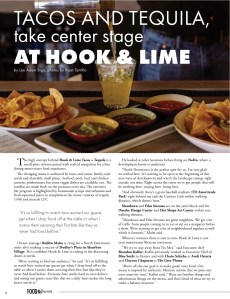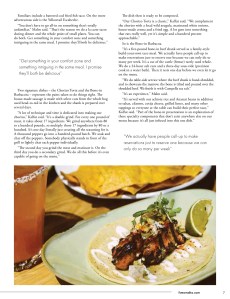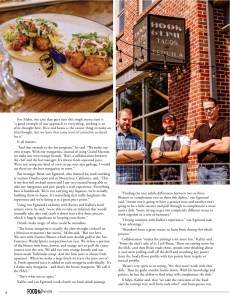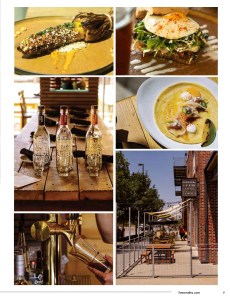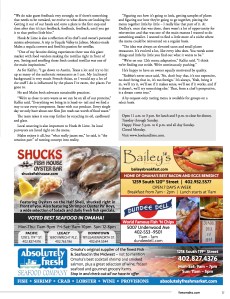Serial food entrepreneur Willy Theisen of Omaha has a methodology for success in life and business that he likes sharing with others. When he’s not making deals or overseeing his various moneymaking ventures, he’s speaking to groups of aspiring and established entrepreneurs about some guiding principles he follows that he feels can help people achieve their dreams. Many of his most attentive audiences are high school and college students who were not born when he had his breakout success with Godfather’s Pizza. He’s had many successes after selling Godfather’s and he’ll be stategizing and pitchng until his dying breath but he’s not just about accumulating weath and possessions these days, he’s also about giving back, and he views passing his wisdom and experience on to others, whether as a speaker or mentor, as a form of public service. My new profile of Theisen in the May-June-July 2017 issue of Metro Magazine (https://issuu.com/metmago/docs/thegivingguideandeventbook2017) delineates some of the key tenets he lives and works by and that he gladly shares with others.
The Motivator.
Willy Theisen
©BY LEO ADAM BIGA

Photo by Jim Scholz
“We Don’t Coast!”
The Greater Omaha Chamber ads say it. Nebraska is motivated and motivational. So is one of her most inspiring success stories, Willy Theisen. This serial entrepreneur who first made a name for himself as founder, chairman and CEO of Godfather’s Pizza Corporation is anything but idle at 71. He still puts in 70 hours a week between his business pursuits and community endeavors.
After selling the brilliantly branded Godfather’s chain he grew to 500-plus franchises, he went on to new hospitality industry adventures. He returned to his roots with Pitch Coal-Fire Pizzeria but doing more refined pies than Godfather’s. With Pitch a hit in Omaha’s prime Dundee neighborhood, he’s opened a new eatery there, Paragon, featuring a completely different concept.
Theisen’s come a long way from his brash rise to fast-food fame and fortune that found him making news for his lavish lifestyle – once renting a Concorde supersonic passenger jet to take him and birthday celebrators to London and back. Over time, he’s devoted considerable energy to civic service work, including serving on the Omaha Airport Authority and Creighton University boards. More recently, he’s been appointed to the Center for Innovation, Entrepreneurship & Franchising at the University of Nebraska Omaha. He’s also been appointed chairman of the Omaha Convention and Visitors Bureau Advisory Board and named a Creighton University Business Ethics Alliance Trustee.
With Nebraska feeling the pinch of persistent brain drain, massive state budget deficits and the loss of major corporate players, this serial entrepreneur is viewed as an economic stimulus expert.
At a recent presentation before Skutt Catholic High School business students and members of Future Business Leaders of America, he said, “Who creates jobs? Entrepreneurs create jobs.” He shared how he was taken aback to learn that in its 44-year history, Godfather’s has created more than half a million jobs.
His proven business savvy is well recognized per his induction in the Omaha Restaurant Association Hospitality, Omaha Chamber of Commerce and Nebraska Business & Commerce Halls of Fame.
Because of his-real world expertise and experience as a self-made man, he’s often asked to present before audiences ranging from professionals to high school and college students. He especially looks forward to interacting with young people because he believes in cultivating and supporting emerging entrepreneurs.
“I really think these people who produce new ideas and share those ideas and have them nurtured is our future job growth in this state,” Theisen said. “I think it’s a must that we identify and nurture them as early as possible.”
He told Skutt students: “Entrepreneurs are people that can see things other people don’t see.”
Theisen and Gallup Global Channel Leader of Entrepreneurship and Job Creation Todd Johnson share a passion for finding and coaching young entrepreneurs. In June, a group of area youth identified through Gallup assessment profiles as high potential entrepreneurs will attend the Omaha Builders Internship at Gallup, and Johnson’s already secured Theisen’s help.
Life Lessons.
“I called Willy and said, ‘I’m going to have the next generation of you here at Gallup for a month, will you engage?’ and he said yes. So he’ll mentor, coach and present to them.”
Johnson said the idea is to be more systematic, scientific and intentional in the early identification and development of entrepreneurial talent.
“Willy and I have really bonded on that project. We’ve socialized it and, I dare say, evangelized it and we’re going to set-up Omaha as a best-practice mecca. Gallup sees Willy right in the middle of the mentoring and coaching of this next generation of entrepreneurs.”
In recent Gallup testing he scored highly in eight of the ten metrics associated with greatly successful entrepreneurs, including knowledge-seeker.
Anthony Hendrickson, dean and professor of Business Intelligence & Analytics at Creighton University’s Heider College of Business, said he admires Theisen’s curiosity about what makes things work.
“He came to the Harper Center to speak to a group of students. I took him on a quick tour of the building, including the food-service kitchens. Willy wanted to walk through those facilities and see what was being prepared, how, by whom, the menus and processes. Willy was just trying to learn if there was anything he might have missed as a restauranteur. Ever the student of business and life.”
Theisen’s public speaking is part of a philanthropic thank-you to the city that supported his big idea.
Van Deeb, a national real estate speaker, author and coach, said, “Willy is spending the majority of his time giving back to the community that made him so successful. We spend a lot of time together and I see it and I feel it. He’s wanting to give to youth hope, direction, inspiration.”
Theisen said, “I make time now. Before, I probably cared just about things more than the impact I could make. I was always too busy working, opening restaurants all over the country. I don’t want to go all over the country. We’ve got a lot of stuff to do right here and it’s not all about restaurants – it’s about people.
“A lot of people are busy all their life and they don’t want to be part of anything. They just let things happen. I don’t want to let things happen – I want to make things happen. When I get done with a project I want it to be better off with my involvement than without it.”
Beverly Kracher, a Creighton business professor and CEO-executive director of the Business Ethics Alliance, said, “Willy is smart enough to see he has power. He’s also a man of character enough to use that power to take care of our community and to act responsibly.”
Johnson said he admires Theisen’s commitment to the Business Ethics Alliance they serve on together.
“We have events across the city throughout the year and you can always find Willy. He’s known as a man that shows up and I think that’s a real important insight into who he is. I can’t think of a time when I asked for Willy’s help and he said no. I sure hope I’m as generous with my time, talent and treasure in 20 years as he is. He’s such a good role model.”
Theisen said his focus on “giving back and paying forward” is something that “comes with age and from involvement in the community,” adding, “It just evolves into this and it becomes more important than not.”
When presenting he eschews prepared notes for a conversational, freestyle delivery that invites talk-back. His message emphasizes certain principles he lives and works by as well as certain truths he believes. One is the importance of first-time jobs and what they teach.
“First-time jobs give young people confidence. They direct you to come in on time, say ‘please’ and ‘thank you.’ It gives you confidence in the things you need to be set up in to succeed. At Godfather’s it just happened that about 80 percent of the 545,000 jobs created during the company’s history have been filled by first-job seekers.
“Working at Godfather’s was a starting point for many young individuals. What’s most fulfilling to me is that they have gone on and bought houses and automobiles, raised children, contributed to society, and that first job was a part of their foundation.”
Growing up, Theisen’s parents modeled and he adopted a work ethic and earning-your-own-way mentality.
“I always had a job. I painted house numbers on curbs, I caddied, I worked in a pool hall, I flipped burgers, I cut lawns, I bagged and carried groceries at Eddie’s Market, I killed chickens in the market’s basement.
“I did a lot of stuff – and all of it matters. All of it got me here today.”
At Skutt he stressed that from humble origins great things can spring forth. Students young enough to be his great-grandchildren listened intently.
“My best audiences are young people,” he said. “I think they’re looking for a direction and I talk right to them, I don’t talk down to them. I relate to them. I want to be something they can count on. I’ve worked with young people in business all my life.”
Dale Eesley, an associate professor in UNO’s College of Business Administration, said, “Willy doesn’t lecture students. He tells them stories from his career and encourages them to look for the best in themselves. He emphasizes hard work – something anyone can do if they set their mind to it.”
Theisen knows any group includes entrepreneurs.
“There’s a handful of them in every audience. They’re there, we’ve just got to find them and show them the opportunity. Hopefully, I can inspire them to maybe have the courage to take it one step further.”
Eesley considers Theisen “a true mentor” figure for youth. “Many times I have arranged for students to seek advice from Willy. On several occasions he has hosted ‘Dinner with an Entrepreneur,’ where four to six students from the Collegiate Entrepreneurs Organization join him at Pitch and get to know him personally as well as professionally. Students all say it’s the highlight of their school year.”
Creighton’s Hendrickson said, “Willy is a tremendous resource for young people, especially aspiring entrepreneurs. He takes time to visit with students individually, listen to them intently and provide encouragement and wisdom about their ideas. He is quick to share the positive potential he sees in their thoughts and plans but equally quick to provide the kernels of truth they need to hear about the challenges they will face. I have referred many students to him.”
Until recently, Theisen said, what few entrepreneurial classes local schools offered were only for graduating seniors or graduate students.
“It’s too late. We can’t wait until they’re seniors to identify them as entrepreneurs. We’ve got to have entry-level. Now schools have departments and programs for entrepreneurship. This is where these ideas come from. They only need one and from one you can take it and make something out of it, and our schools now nurture that out of people.”
Theisen tells students none of this support existed when he was their age. “The word ‘entrepreneur’ wasn’t even used. We were called futzers or daydreamers.”
So much of what forms us, he tells audiences, is our habits. His checklist of positive habits to follow includes “showing up on time, being a person of character and being credible.” He encourages those working first jobs to foster traits that develop good lifetime habits that connote trust. “Be dependable, come in early, stay late. Make the boss look great. That’s how you advance.”
He said along with doing things right “comes confidence, then ethics and then trust,” adding, “I want to get people to where somebody can look at them and say, ‘I trust you, I can count on you, because you’re here on time, ready to work.’ I tell young people you gotta be ready to work when the opportunity is there. Don’t say, ‘Can I get back to you on this?’ Someone else will do it.”
He said the trust that flows from being ethical in business is not a legal requirement but “it sure helps to be a person of your word.” Besides, he said, “It is the right thing to do and the relationships are so much better when you’re ethical. No hidden agendas, no backroom deals, no going around in an underhanded way.”
He built his first business empire on trust.
“From 1977 through 1979 I opened 450 Godfather’s Pizzas in 36 months. You couldn’t have done it if you didn’t trust each other, if you weren’t ethical, if you picked the wrong partner to go into these things with. None of it would have happened.
“Some of the first franchise deals we had back in 1974, we didn’t have written agreements. You know what we had? You grabbed a person’s hand and you looked at them right in the eye and took them at their word.”

Long before franchising became an option, Theisen had to sell a banker on a dream.
“Something life-changing for me happened in late 1972. I went over to Southwest Bank to get a small business loan. I was nervous. The lending manager I met with, Joe Sullivan, said, ‘What’s your idea?’ ‘Well, what I’m going to do is I’m going make a big, thick pizza with a bunch of toppings on it and I’m going to put my store right in the middle of Thomasville Apartments. There’s 500 or 600 people living there and everyone’s going to come there; nobody’s going to cook.’”
Theisen, who worked for a real estate developer then, had no real collateral other than his vision and belief.
“All I had was a rough ballpoint-ink outline of the building on a cocktail napkin. Joe looked at me and said, ‘Where’s the rest of your business plan?’ ‘That’s it.’ He stared at me, and said, ‘I like it, it’s simple, I understand it.’ He gave me Small Business Administration loan papers. He guessed I wasn’t good at filling out forms and said, ‘I’ve got a guy.’ He asked, ‘Do you work at night?’ ‘Yeah, I work at night,’ ‘Will you start tonight?’ ‘Yeah, I’ll start tonight.’ His accountant and I got those forms filled out and I got the loan. You know what Joe made that day? He made a character loan. He made me a loan. That’s what I call the Sullivan Effect.”
Additionally, Sullivan offered some sound advice via an admonition. “He said, ‘When you open your place, I want to see you there.’ I asked my business partner at that time, Greg Johnson, ‘What do you think that means?’ ‘It means you’ve got to be there all the time.’ I was there all the time. That’s the Sullivan Effect, too.”
Business Ethics Alliance activities have given Theisen fresh insights into lifelong practices.
“I thought I was always doing the right thing but now I know I’m doing the right thing, and I get a little more satisfaction out of it.”
Of his fellow Alliance trustees he said, “It’s evolved into quite a good list of individuals. It’s not a coincidence most of them are leaders. They got there being that.”
Creighton’s Kracher said Theisen brings credibility to advising about jobs since he’s created so many.
“He grooms young people to help them understand what it means to work hard, to show up on time, to be accountable, to be trusted – all those character traits that matter if you are going to be a business person.
“He takes the time to educate students that half of life is about showing up and in his fundamental belief that business and life is based on trust.”
She said his charisma plays equally well with students and seasoned business professionals.
“You can’t help enjoy hearing him speak and then afterwards telling five people what you heard.”
Theisen stresses to audiences the building blocks of success must be cultivated. “This just doesn’t happen,” he said. “You don’t wake up one morning and get this when you’re 69 years old. This is the fabric and core of who you are and how you treat and greet others.”
As a veteran restauranteur he knows how key quality control is. It’s why he shows up to observe and listen. He always checks the restrooms to ensure they’re clean. He stops to ask diners about their experience. He follows orders from the kitchen to the table to see if they’re coming out right.
One night at Pitch he followed an onion rings order from the kitchen to a table where two young women sat sipping cocktails. He regaled them with what makes the rings so fresh and special when one woman interrupted to say, “Willy, we trust you.” “And it kind of took me,” he said. “It’s all I’ve ever worked for. It’s the core and fabric of what I am. Everything I am is to be trusted.”
Built on Trust.
“Trust”, he told Skutt students, “means everything to me. It doesn’t come quick, it doesn’t come easy. You’ve got to earn it every day. That’s one of your strengths.”
No detail’s too small for his attention. Nothing gets overlooked, ignored or abandoned.
“I try to talk to young folks about solving small problems. I’m a master at solving small problems. I try to have big ideas sometimes, but I want to solve small problems. If you’re driving to an appointment and you cut yourself short on time, you make yourself late and thus less credible, and I try to teach people how important that is,” he said.
“I generally ask, ‘How many of you made your bed this morning?’ I make the point it’s the first achievement of the day. There’s research showing you’ll be happier several percentage points by doing that one thing. Your day flows from there because it’s done. Then you clean up, get dressed. It organizes you and gets you set to take on things.”
Kracher said, “He’s a perfectionist and that perfectionism has driven him to the successes he’s had. He looks at every single detail over and over, down to the toilet paper in his restaurants’ restrooms.”
Theisen’s never without a to-do list.
“This is my to-do list,” he said, holding a small sheet of memo paper filled with entries. “I’m going to finish it and then I’ll have another list for tomorrow. But you have to finish things. You can’t leave everything half-assed, half-done. That’s what I tell people. You have to show up, you have to be prepared and you have to finish things.
“That’s who I am, that’s how I live my life. Successful people are finishers. If you’re a finisher, you’re going to be successful.”
In his talks, he said, “I really provoke thought. They remember me when I leave. That’s my job. That’s one of the reasons I’m there. I give them points to think about and I present in an untraditional way.” In a given session, he said he and students get around to discussing “food and beverage, hospitality, politics, education. Omaha’s generous philanthropic community and the philosophy of giving back and paying forward. We talk about a lot of things. It’s fun for me and them.”
Theisen doesn’t just engage with audiences of privilege. Through his work with UNO he visits inner-city schools to interact with diverse students, many of whom come from trying circumstances.
“This past summer my friend Van Deeb and I visited several inner-city high schools together – Blackburn, Central, South and Benson – to let them know UNO is an option to help people be entrepreneurs if they want to be entrepreneurs. It’s not for everybody.”
He said, “Something eye-opening happened at Benson. I was miked up, walking back and forth on stage, chatting, when I looked down in the front row and this young man was sound asleep. I looked over at the guy next to him and said, ‘Wake ‘Junior’ up, would you?’ So he gave him a shot and ‘Junior’ sat up.
“When I got done I was getting my things together on stage to join the students for Godfather’s pizza when I saw ‘Junior’ approaching me stage left. He’s a big guy. I thought, ‘This can go either way.’ He towers over me and I look up and he says, ‘Mr. Theisen, I want to apologize for falling asleep.’ I asked, ‘Who told you to come up here?’ ‘Nobody, I come on my own. After I did get with it, I heard you have to man up and take ownership for everything you do. That it’s not a blame game.’ So he shook my hand and as we walked off stage he put his arm around my shoulder, and I think I changed him for only a minute. He changed me.
“It was humbling. I’m up there to teach some takeaways, positive direction, leadership skills as sort of a life coach, and when he came up it tore at me because he heard enough that it changed him. It reminded me how fortunate I am to be in front of those students. He took my words to heart and that made my day and made it well worthwhile going there and sharing. I know I made an effect on one person for sure and hopefully many more. I take away so much more then these kids get. I’m the beneficiary of this when I get done with one of these groups. I love it.”
He’s well aware many of the urban kids he addresses face challenges their suburban peers do not.
“I was at Blackburn and this girl was asleep when I walked in the room. This was a group of students that had left school and were coming back to graduate. They were a little bit older and they were on a mission. I said to her, ‘You probably need a little more sleep,’ and she said, ‘Yeah, I do, because I’m pregnant.’ I said. ‘Well, you know, others have been where you are and you’ll get through it. By coming here you’re going to get a high school degree and things will get better.’”
Connecting.
“They have tough lives. Listening to them, having empathy for them and encouraging them are among the things I try to give back. They don’t want me to sit up there and bark at them for an hour. I talk to them and I draw out of them things. They must trust me or they wouldn’t tell me.”
Todd Johnson said Theisen instinctively reacts to his audience and adapts as needed.
“No matter the setting or audience, Willy manages to engage. He figures out a way. And if you think about entrepreneurs, they always figure out a way. They see or hit an obstacle and they go over it, around it, under it and I think that applies to his community involvement and communication.
“He can read a room and adjust on the fly if he has to. He’s pretty good at that and he keeps it snappy.”
Van Deeb said he’s impressed by Theisen’s ability to reach people.
“I truly admire how he connects with youth. He relates to them. He commands the room. You can hear a pin drop. They listen to every word he says and he’s not just talking about being successful in business. He’s talking about how to be successful in life. Treat people well, do what you say you’re going to do, be on time. He never brings up his financial success. It’s never about making money, it’s about being a good person, and it’s refreshing.
“What I see in Willy is he cares about people. He wants to be significant in people’s lives. When I look at these students’ faces, it’s clear they’re learning from him.”
Far from the public eye, Theisen also personally intervenes in the lives of young people in crisis or at crossroads.
“Some people come into my life that are on the wrong track and need help getting over humps. I get gratification from seeing somebody get on that right track and do well. As a respected friend of the family I can often come in and talk to kids better than the parents can. I go in pretty straight-forward – here’s what we gotta do, no nonsense, no excuses.
“Many a time I get their attention when everything else has failed. We agree one-on-one what we need to get done. It’s better that way. I make the young woman or man responsible and we get on a timeline and we start. I don’t want to get disappointed and I don’t want to disappoint them. so we’ve both got to do X to get to where we’re going.”
Theisen didn’t come from money and he’s worked for everything he’s gotten. He’s had his own setbacks, both personal and business. He faced a serious health issue several years ago. He knows what it’s like to struggle and fail, though he likes to think of those misfortunes as “things that just didn’t work out.”
All of it’s given him a heart “for the little guy.”
“I’m a guy for second chances, I really am,” he said. “I don’t give beatdowns. It used to be one-and-done with me. As I’ve gotten older, I feel it’s more important to give second chances. I’ve seen people that have tried really hard to live up and they can’t do it the first chance and so I give them another. I know when somebody’s really trying and they just need a little more time.”
Whether for kids or adults, his how-tos are the same.
“There are steps I want people to take. To be formidable, competitive, resilient. To be mindful. To have empathy. To take and have ownership. To be a person of your word, I want people to know I walk the talk. I’m somebody you can count on.
“These are just words but there’s true meaning behind every one. My epitaph, if I do have one, would read: ‘He was a good guy who tried right some wrongs over the course of his life.’ That’s a big deal to me.”
Theisen doesn’t dwell on his mortality, not with a granddaughter to dote on, projects to work on and commitments to keep. But he’s aware each passing year brings him closer to the end.
“What I’m not going to do is waste one day.”
He’s never been more content or grateful knowing his purpose in life as a builder and creator is never really done and may even outlive him.
“I have good health and good fortune. I try to eat right. I hit the gym. I get enough sleep. Yeah, I’m very happy. I’ve not been any happier. I look forward to tomorrow and the next day. I don’t look back much. I want to move forward. I’ve got so many things to get done. I have to solve small things in each of them. They need me.”
“My epitaph, if i do have one, would read: ‘He was a good guy who tried to right some wrongs over the course of his life.’ That’s a big deal to me.”
~ WILLY THEISEN
Read more, including what young entrepreneurs have to say about Willy Theisen’s motivational impact on their lives, in our DIGITAL EDITION.
Share this: Leo Adam Biga's Blog




